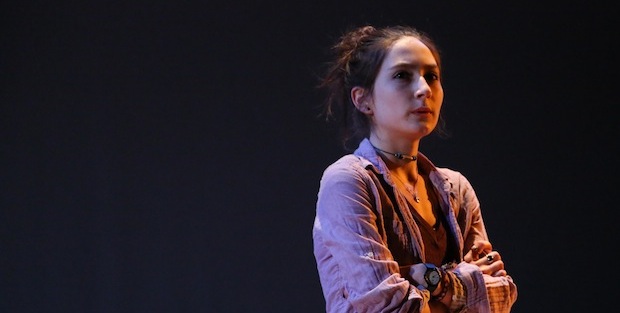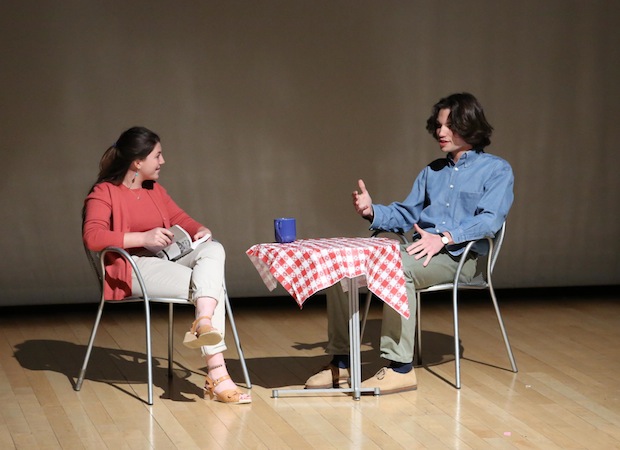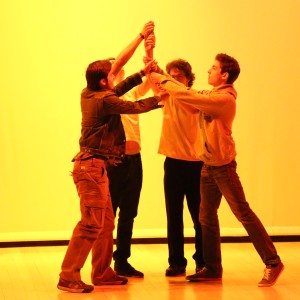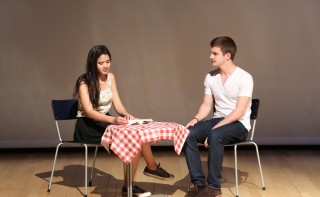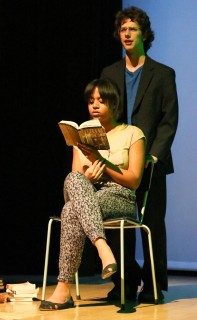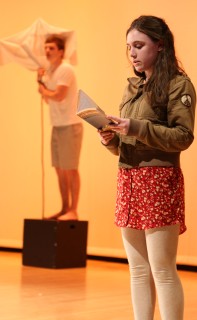The seats in the auditorium were empty. It must have been around 8:30 pm, the evening before opening night. All 17 members of the cast were on stage, some cross-legged on the floor, others sitting on chairs, each attentive to the performance notes being given. Charlotte and Emmett, the two student co-directors of this year’s English language theater production, commented on the breathlessness of one character, the hesitancy of another.
Charlotte and Emmett on stage.
Their remarks were full of praise for the acting they had seen, but clear too about the work which still needed to happen. They were brilliant, making one incisive observation after another, always finding just the right words. Emmett would pick up where Charlotte would leave off; Charlotte would build on something Emmett would say. As a witness to what I am describing, I was struck by how much this directorial team appeared to be modeling the very harmony with which they wished to infuse their show.
And I write “their” show because the production our English-language theater troupe was rehearsing had been conceived and almost entirely written by these two twelfth grade students, with invaluable support from faculty advisor James Boobar. The show starts with a short, 20-minute one-act penned by contemporary American playwright David Ives, entitled “Sure Thing”, “featuring a chance meeting of two characters, Betty and Bill, whose conversation is continually reset by the use of a ringing bell, starting over when one of them responds negatively to the other. The play begins with Bill approaching Betty in a café, asking ‘Is this chair taken?’ To which she replies ‘No.’ The bell rings and Bill repeats his question to which Betty says, ‘No, but I’m expecting somebody in a minute.’ The bell rings again, and Bill poses his question again. This process continues until Bill is finally allowed to take a seat. The bell acts as a buffer against all topics of conversation that are potentially negative to building their relationship, allowing them to try another line. By the end of the play, their initial differences in opinion…have reversed to become perfect companions. Both of them finally agree to fall in love and cherish the other forever” (http://en.wikipedia.org/wiki/Sure_Thing_(play)).
Playwrights Charlotte and Emmett then follow this first part with their own longer, 40-minute extension, “The”, which employs the same bell technique and many allusions to Ives’s text to create a constellation of some 20 additional sequences linked in one way or another to the initial Betty-Bill encounter(s). Charlotte’s and Emmett’s stage directions open: “BILL and BETTY’s table is moved upstage-left where it remains for the time being, BILL and BETTY undergo a slight costume change (BILL now wears a sports-jacket over his shirt, BETTY’s hair has changed and she bears more mature accessories). Finally, the clink of a spoon on a glass is heard as is the sound of conversation and laughter. Lights rise to reveal the ENTIRE CAST, scattered in groups of twos and threes in a semi-circle around center-stage. All turn to BILL as he raises his glass in a toast to his dear friend FABIO, the café-owner.”
A glorious multitude of scenes ensues, each as exquisitely written, and, if you had the immense good fortune of seeing this production last Tuesday or Wednesday evening you will know, each as beautifully performed as the next. The production was exceptional, exceptionally witty, exceptionally illuminating and exceptionally moving, something one might have watched downtown or about which one might have read a rave review in the New York Times by critic Charles Isherwood. It was that good!
Of course, while watching Charlotte and Emmett in action, not to mention the other members of their splendid cast, Baptiste, Benjamin, Caroline, Charlotte F. , Chiara, Etienne, Francesca, Isabella, Josephine, Julia S. , Julia S.-S. , Lucas and Sarah, the educator in me could not help but think of a double question which the great American educational reformer Ted Sizer once asked: what should we hope students will learn by the time they finish their secondary schooling and how can we best assess the extent to which they have mastered whatever it is we aim for them to master in our care? For Sizer, our most important aspiration should be for our students not only to excel on aptitude and achievement tests, but to be able to demonstrate their intelligence and imagination through various kinds of performance or what he called “exhibitions.”
According to Sizer: “In its original form, the exhibition is the public expression by a student of real command over what she’s learned…It began in the eighteenth century, as the exit demonstration in New England academies and in colleges like Harvard. The student was expected to perform, recite, dispute, and answer challenges in public session…It’s the first real step towards coming up with some ideas of their own” (http://www.essentialschools.org/resources/123). Dear readers, with Charlotte and Emmett as outstanding examples, along with countless other illustrations from across the Terminale class which is graduating this spring, we can safely and proudly say that our high school students have done much, much more than take that first step of which Sizer speaks. They are brimming with their own ideas and capable of inventing whole worlds of their own design. Bravo and thank you to them all!
NB: The title for my post this week, translated from the English “All the world’s a stage“, is a quotation from William Shakespeare’s As you Like It, Act II, Scene 7.
About the Author :
Sean Lynch was Head of School at the Lycée Français de New York from 2011 to 2018, after having spent 15 years at another French bilingual school outside of Paris: the Lycée International de St. Germain-en-Laye. Holding both French and American nationalities, educated in France (Sciences Po Paris) and the United States (Yale), and as the proud husband of a French-American spouse and father of two French-American daughters, Sean Lynch has spent his entire professional and personal life at the junction between the languages, cultures and educational systems of France and the United States. In addition to being passionate about education, he loves everything related to the mountains, particularly the Parc National du Mercantour.

